- Series:Animals, Transcript English
Genesis 1:25
“And God made the beast of the earth after his kind, and cattle after their kind, and every thing that creepeth upon the earth after his kind: and God saw that it was good.”
 There was a certain hydroelectric dam built in Brazil. This involved the flooding of a region of countryside, which left some populations of geckos isolated. Gradually, the populations of other lizards in the area died out. After about 15 years, it was noticed that the geckos in the area had “developed” larger mouths in order to eat large insects that would formerly have been eaten by larger lizards. Is this evolution?
There was a certain hydroelectric dam built in Brazil. This involved the flooding of a region of countryside, which left some populations of geckos isolated. Gradually, the populations of other lizards in the area died out. After about 15 years, it was noticed that the geckos in the area had “developed” larger mouths in order to eat large insects that would formerly have been eaten by larger lizards. Is this evolution?
One is being led to believe that the ability to have bigger mouths is a brand new piece of genetic information in the geckos, causing it better to survive. This is not the case. The information to produce these large mouths was already present. There would, previously, have been the occasional gecko hatched with a big mouth. But it would have had no survival advantage, and possibly some disadvantage, so would not be able preferentially to breed. However, in the new circumstances, supplies of bigger insects were more readily available, so the big-mouthed geckos would find it easier to survive, compared to their small-mouthed relatives. Therefore, the big-mouths would be preferentially selected. It is important to notice that no new genetic information was created in this process. This is an example of adaptation. The evolutionist, however, likes to refer to this process as microevolution so that they can claim that Darwinian macroevolution is simply a step up in complexity. This deliberate attempt to use the same term for two different phenomena is known as “bait and switch” and is a recognized logical fallacy.
Thank You, Lord, for making everything well. Thank You for putting variation into the genetics of so many creatures to help them survive. We pray, Lord, that You will make us to be good stewards of the portion of creation for which we are responsible. Amen.
Author: Paul F. Taylor
Ref: accessed 8/29/2017. Image: Jurriaan Schulman, Creative Commons Attribution, Share-Alike 3.0 Unported.
